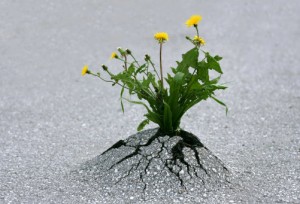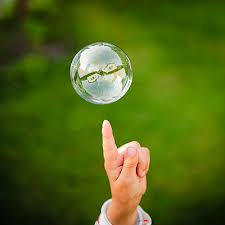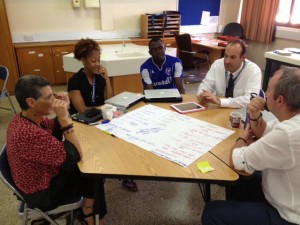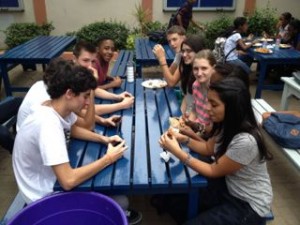…..meaning can be found in every event. How meaningful depends on the manner in which people are involved and engaged. No matter how small, an event experience has the power to engage people, let them escape the ordinary, and build relationships. https://medium.com/@bobhoranjr/why-we-crave-shared-experiences-5443afba6405
A while back….some would say a long long time ago….okay, it was April 1989….I was enrolled in a course called Perspectives on the Principalship. It was a weekly seminar for about 15 graduate students and it was held at the Principals Training Center at Harvard. It was about leadership and the Principalship. At least that’s what I generally remember. But, what I remember most from the course and, frankly, it’s one of my top 5 memories of my Masters program at the Ed School at Harvard was a Saturday expedition that our group made on a rainy/chilly Saturday in April.
The boat to Thompson Island in Boston Harbor left around 8:00 am. The Outward Bound ropes course, and other team building, experiential education challenges, was to be our morning activity. It was my first high ropes course. It was Outward Bound….it was cold, wet, and daunting!! The highlight, however, was a specific rope challenge that you had to complete with a partner. My partner was my professor, Dr Sara Levine. Truthfully, we didn’t really have much of a connection throughout the course up until that point. It was absolutely necessary to cooperate with your partner to make it over the hurdle. I remember struggling together to get up and over, failing at first, then finishing the challenge. I remember the absolute relief, sense of accomplishment, and a very strong bond that was shared between the two of us following our success. As the day was processed – written about in journals, discussed in an on-site debrief and then again in our classroom, I remember the expression “power of shared experience” being used, emphasized, and truly felt by everyone involved. While intuitively I understood from past experiences that this was important, the experience on that day in April, 1989 was a truly formative one in deepening my understanding of the importance and opportunities that shared experiences, particularly around discomforting challenge, provide. The depths of potential learnings were truly uncovered for me. It remains an important moment landmark memory.
“Shared experiences have the ability to fuse people together, sometimes people who wouldn’t have even made sense together outside of that context. Simply put, that’s powerful.” https://medium.com/@bobhoranjr/why-we-crave-shared-experiences-5443afba6405
Last week I travelled for 3 days / 2 nights on a trip with our Grade 9 students. A goal of the trip, at the outset of the year, was “bonding” and building connections with classmates & teachers. I was reminded at every turn of the value of such experiences. The organized activities that each group of students participated in from zip lining to orienteering to solving various human puzzles through cooperative movements, challenged students to work together, interact productively, and manage stress and challenge. The building of stress through challenge, pushing students out of their comfort levels in front of their peers, forcing students to take certain risks (albeit minimal). This is the edge where opportunistic learning takes place. It’s where comfort meets stress. It got me thinking a bit about flow theory:
“Optimal experience, or flow, occurs when a person perceives the challenges in a certain situation and the skills brought to it as both balanced and above average.
In contrast, when challenges and skills are unbalanced, such as when challenges outpace skills, an activity could evoke anxiety. The various ratios of challenges and skills are predicted to be associated with different qualities of experience: flow with high challenges and skills, apathy with low challenges and low skills, anxiety with high challenges and low skills, and boredom or relaxation with low challenges and high skills”. http://www.education.com/reference/article/flow-theory/
We need to provide such experiential challenges for students. They are particularly powerful when the challenges are incorporated into a group process – either performing as a group or in front of a group. Then the challenge becomes not only the task but the potential exposure to failure/success in front of peers. This is adds multiple layers. The trick is to provide just enough challenge so that skills can meet the challenge and excessive anxiety does not result! It’s a great challenge in experiential education as well as the day to day classroom challenges.
Experiences outside of the classroom hold such power. How we capitalize on that potential and help translate it to actions “back at the ranch” (aka the school or classroom) is another story. Teenagers are skilled at separating their worlds – the field trip, the classroom, the lunch table, the dinner table, the hallway, the bus ride, FB, Instagram, WhatsApp, the sports team….etc etc. “Code switching” between conversations and their multiple worlds is a highly developed skill for our multi-tasking population of teenagers. The layers are more complicated these days without doubt. So, the challenge of translating the “bonding” shared experience back to the classroom is significant given the multiple layers of daily experiences kids shuffle through.
Having said that, our students are social beings and everyone, I’m convinced, craves the sharing of experiences, the connections that these build, and the memories that they create. As well, learning from a collection of experiences over time and rolling that “snowball of experiences” into a snowman of memories truly shapes the character of a person. And, as our students are on a constant path of “becoming”, any and all positive shared experience will continue building the persons they are becoming.
http://www.theatlantic.com/health/archive/2014/10/the-importance-of-sharing-experiences/381493/
http://www.edutopia.org/blog/student-engagement-elena-aguilar
http://edutechwiki.unige.ch/en/Flow_theory




